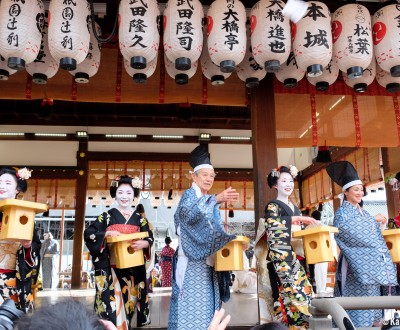Setsubun
End of winter and beginning of spring celebrations
Setsubun, also called "bean-throwing festival," is an annual tradition held each February 3 in Japan. It celebrates the first day of spring (risshun 立春) according to the former Chinese lunar calendar and it is the most important passage to another season in the year.
First introduced by the imperial court of Heian during Japanese antiquity (794-1185), it diffused in Japanese society throughout Edo period (1600-1868). Despite its importance for Japanese people, Setsubun is a working day. The celebration conveys two intents:
- Chasing away the previous year’s evil spirits and attract luck for the new year;
- Celebrating the coming back of spring 🌸.
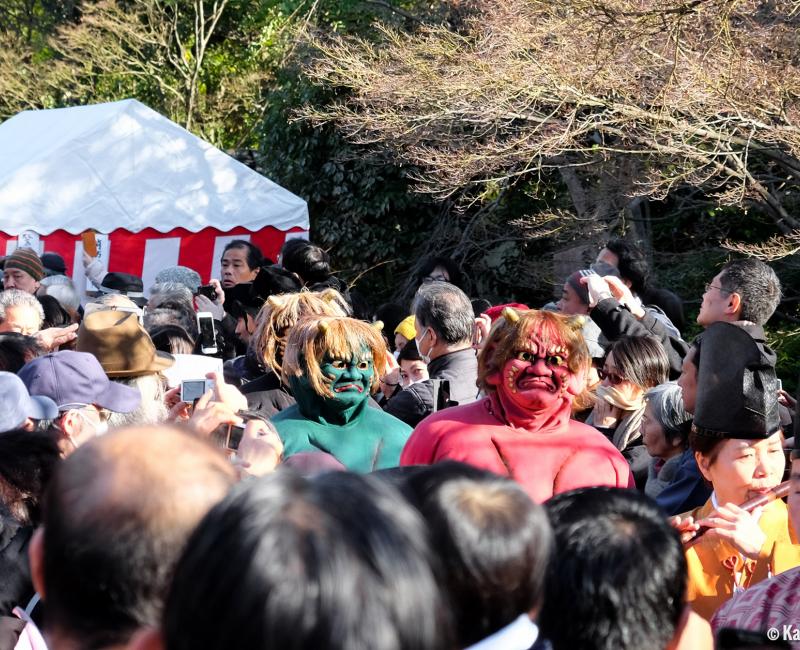
Exorcising the house
"Oni wa soto! Fuku wa uchi!" is the chanting phrase to sing at this time of the year. It symbolizes Japanese people’s wish to chase away oni demons and attract happiness. For this purpose, it is possible to purchase ready-made "setsubun kits," including a mask 😷 of an oni demon and a bag of Fukumame beans in a wooden square ramequin.
Someone in the family dresses up as a demon and goes through the house while the others (gently) throw handfuls of beans to chase them away. This joyful activity, called Mamemaki, is often performed by children. At the end of beans-throwing, the family gathers the beans to eat them. It is said that one must eat a bean per year according to one’s age, plus one more for good fortune in the next 12 months.
Another custom, however less endearing, consists of hanging a Hiiragi Iwashi, a scarecrow to drive away demons, to the front door. No doubt demons will be scared by this holly branch set with a dried sardine head on top!
A maki for good luck
As often in Japan, to each custom a culinary specialty. Supermarkets and konbini have completely mastered the mercantile interest of this celebration, as they have been contributing in the nationwide adoption of the ehomaki custom since the end of the 1990s. It was an ancient tradition from Kansai: one must eat silently a whole maki, without cutting it, looking towards a propitious direction supposed to bring luck, on February 3 evening.
So, look the right way if you want to try on the ehomaki custom:
- In 2025, eat facing west / south-west;
- In 2026, facing south / south-east;
- In 2027, facing north / north-west;
- In 2028, south / south-east;
- In 2029, east / north-east;
- And so on, on a 5-years cycle.
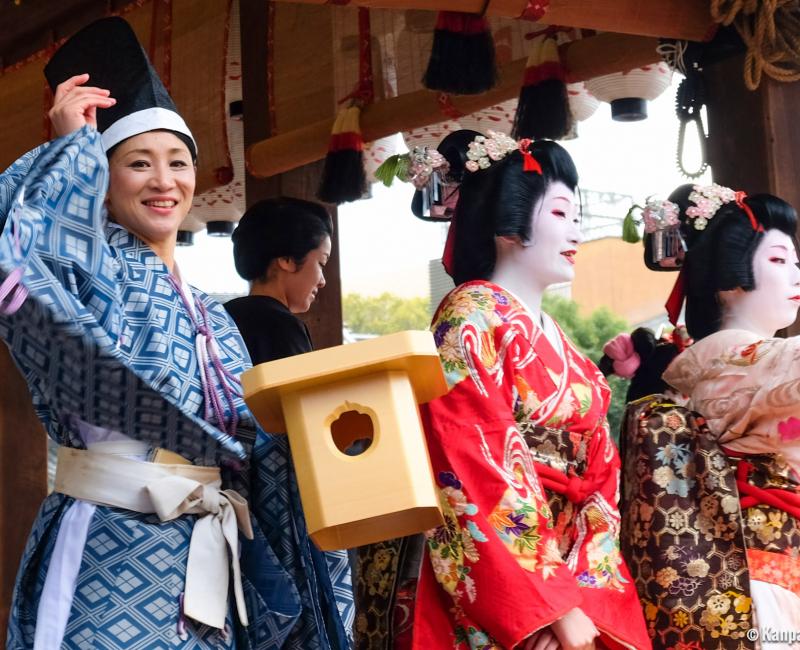
Where to attend traditional ceremonies
Lively Setsubun ceremonies are usually held at shrines and temples, on February 2 and 3, between 11 a. m. and 4 p. m. Local celebrities are guests to the religious places and invited to throw soybeans on the dense crowd.
Neighbors are quite fond of this tradition, and especially elderly people who come in number when Setsubun is on a weekday and February tourists are scarce. As a symbol of communion, each temple or shrine serves amazake - a sweet, low-alcohol sake 🍶 - for about ¥300 (~US$1.90) the cup.
Amongst the liveliest ceremonies in Tokyo are those of Senso-ji and Zojo-ji temples, as well as Hie-jinja shrine’s, where you can even meet Sumo wrestlers. In Kyoto, Rozan-ji temple offers a joyous demon dance. As for Yoshida-jinja, that used to host the biggest ceremony, the celebration was toned down and the shrine now hosts a more confidential night event from 11 p. m.
If you are interested in discovering this tradition, you can have a try of two different kinds of Setsubun celebrations at Yasaka-jinja and Heian-jingu in Kyoto.
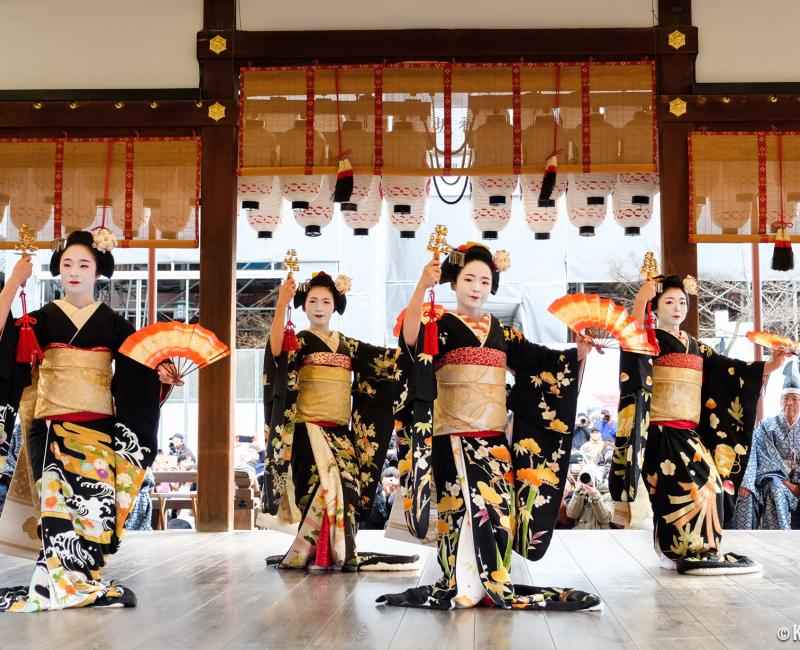
Yasaka-jinja
Setsubun in Yasaka-jinja is characterized by several dance performances by Geisha on outdoor stages specially set up for the festival. For two days, on February 2 and 3, Geisha apprentices, or Maiko, originating from various hanamachi (Geisha districts), like Pontocho, Miyagawa-cho and Gion offer a traditional dance to visitors.
During a rather usual shinto ceremony, two Maiko perform a subtle and delicate dance. They then get closer to the public for the mamemaki, or bean-throwing, while shouting "Oni Yaro!" several times during the celebration. Then another group of Maiko, with special makeup – especially on the nape of their neck - and attire, appears for another graceful dance.
The warm atmosphere is particularly lit up by Geisha smiling faces. Maiko on leave are also keen on celebrating Setsubun, and although they appear without makeup, it is still possible to identify them thanks to their traditional hairdo.
Setsubun in Yasaka-jinja is quite appreciated by the districts’ inhabitants, and its central location helps gathering an important crowd. Access to the stage is free, but speeches and explanations are only in Japanese.
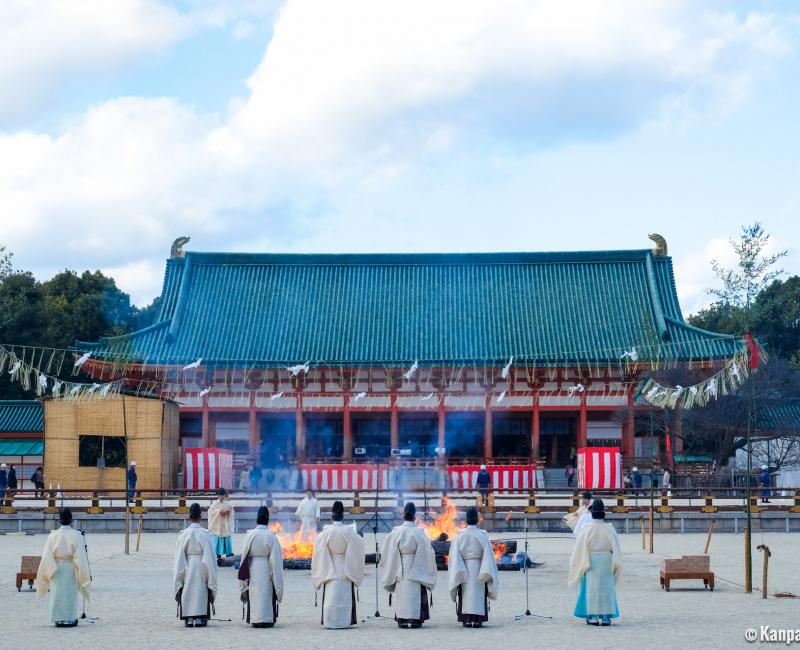
Heian-jingu
The atmosphere of Setsubun at Heian-jingu shrine is quite the opposite, as the celebration focuses on shintoist spiritual aspects. General public can attend to the Dainanogi traditional ritual starting at 2 p. m. on the large esplanade in front of Heian-jingu. After the beans-throwing, a great fire 🔥 ritual is performed to end the celebrations, at 4 p. m.
Although the place is wider and the access is free, there is no dense crowd in Heian-jingu, which benefits from a quieter ambiance than its more famous counterpart, Yasaka-jinja.

